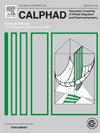基于机器学习的铝硅合金多目标优化设计
IF 1.9
3区 材料科学
Q4 CHEMISTRY, PHYSICAL
Calphad-computer Coupling of Phase Diagrams and Thermochemistry
Pub Date : 2025-08-25
DOI:10.1016/j.calphad.2025.102870
引用次数: 0
摘要
本研究提出了一种系统的铝合金反设计方法,将机器学习(ML)与多目标优化相结合。基于包含3790条合金记录的工业数据集,构建了包含14种元素的质量分数和160个加权原子描述符的数据库。正向特征选择确定了最佳描述子子集-布氏硬度(HB)的19个特征和电导率(EC)的14个特征。对几种回归算法的比较评估表明,极端梯度增强(XGBoost)是最准确的预测器。将优化后的XGBoost模型与期望改进(EI)准则相结合,构建多目标期望改进(MOEI)函数,并利用粒子群优化(PSO)实现该函数的最大化。该迭代过程最终得到Al-5.86Si-1.93Cu-0.56Mn-0.65Mg-0.28Cr-1.67Ni-1.36Zn-0.10Ti-0.92Fe-0.049Sr (wt%)的铸态合金成分,在HB和EC之间达到了最佳平衡。基于calphad的热力学计算和显微组织验证证实,该合金达到了96.1 HB和24.4% IACS。实验测量值与预测值的偏差小于3.5 HB和2.2% IACS,表明逆设计工作流可以在实验不确定性范围内重现目标特性。本文章由计算机程序翻译,如有差异,请以英文原文为准。
Multi-objective optimization design of Al-Si alloys based on machine learning
This study proposes a systematic inverse-design methodology for aluminum alloys, integrating machine learning (ML) with multi-objective optimization. Based on an industrial dataset comprising 3790 alloy records, a database was constructed, incorporating the mass fractions of 14 elements along with 160 weighted atomic descriptors. Forward feature selection identified optimal descriptor subsets-19 features for Brinell hardness(HB) and 14 for electrical conductivity(EC). A comparative assessment of several regression algorithms identified Extreme Gradient Boosting (XGBoost) as the most accurate predictor. The optimized XGBoost models were coupled with the expected-improvement (EI) criterion to construct a multi-objective expected-improvement (MOEI) function, which was subsequently maximized using particle swarm optimization (PSO). This iterative procedure converged on an as-cast alloy composition of Al-5.86Si-1.93Cu-0.56Mn-0.65Mg-0.28Cr-1.67Ni-1.36Zn-0.10Ti-0.92Fe-0.049Sr (wt%), striking an optimal balance between HB and EC. CALPHAD-based thermodynamic calculations and microstructural validation confirmed that the alloy achieves 96.1 HB and 24.4 % IACS. Experimental measurements deviated by less than 3.5 HB and 2.2 % IACS from the predictions, demonstrating that the inverse design workflow can reproduce target properties within experimental uncertainty.
求助全文
通过发布文献求助,成功后即可免费获取论文全文。
去求助
来源期刊
CiteScore
4.00
自引率
16.70%
发文量
94
审稿时长
2.5 months
期刊介绍:
The design of industrial processes requires reliable thermodynamic data. CALPHAD (Computer Coupling of Phase Diagrams and Thermochemistry) aims to promote computational thermodynamics through development of models to represent thermodynamic properties for various phases which permit prediction of properties of multicomponent systems from those of binary and ternary subsystems, critical assessment of data and their incorporation into self-consistent databases, development of software to optimize and derive thermodynamic parameters and the development and use of databanks for calculations to improve understanding of various industrial and technological processes. This work is disseminated through the CALPHAD journal and its annual conference.

 求助内容:
求助内容: 应助结果提醒方式:
应助结果提醒方式:


